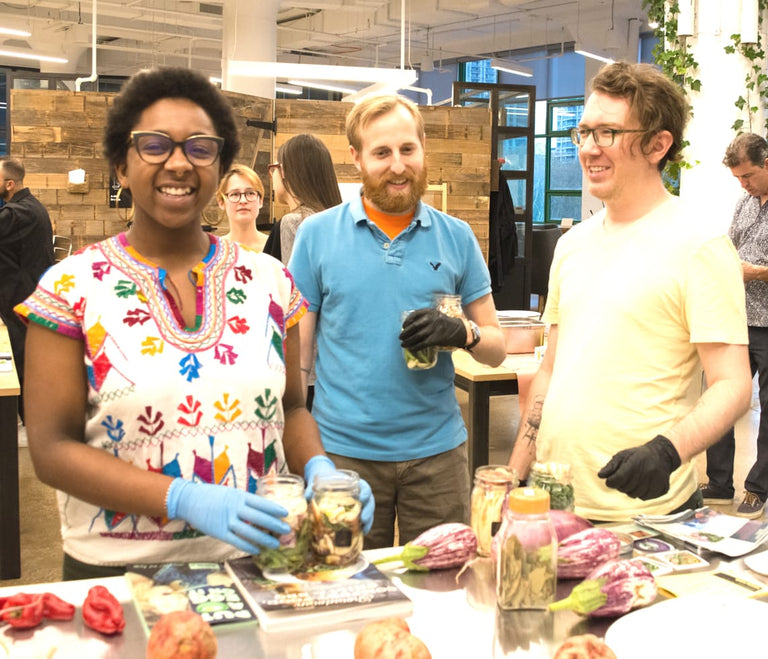The Benefits of Eating Raw, Plus Dips and Tricks to Go With It!
It’s true that most recipes involve and even depend on cooking most ingredients, but this isn’t the only way we can consume produce to induce a healthy life. Of course, the benefits of eating raw can include the elimination of cook time, but they’re also are nutrient based as well. In fact, research suggests that when we eat raw, we allow ourselves access to nutrients different from the ones we attain eating cooked produce. Uncooked veggies offer us access to nutrients otherwise unavailable from cooked foods.
Nutritionist, founder & owner of Abby’s Food Court, Abby K. Cannon, considers the most important aspect of a healthy diet to be variety. According to Abby:
In general, the bioavailability, meaning the body’s ability to absorb the nutrients from the foods we eat, is higher when we cook foods. However, this is not the case for certain key nutrients, including most water soluble vitamins. Carotenoids (antioxidants that are precursors to vitamin A), vitamin C, vitamin E, and thiamine are heat sensitive, so eating raw foods that contain these nutrients is preferable. By eating some vegetables raw and some vegetables cooked, you’re able to consume a balance of nutrients!
Of course, there are pros and cons for eating raw and cooked; cooking produce does not mean losing the nutrients it contains. In fact, eating solely raw foods can bar us from the unique benefits of cooked ones, including digestibility. In this sense, the cooking process helps break down the food, which leaves less work for the digestive system, says Abby.
Abby urges caution where selectivity is concerned, noting:
It’s incorrect that cooked vegetables aren’t good for us and that a raw food diet is the only healthy diet. It’s also important to note that different diets work for different people for varying periods of time. Flexibility and having an open mind is key to developing the healthiest relationship with food.
In keeping with the idea that health in general takes an individualized approach, the same holds true for eating cooked and raw foods. Abby suggests:
In general, it’s great to think about having cooked and raw vegetables throughout the day. If you have a salad with mainly raw vegetables for lunch, aim to have cooked vegetables at dinner. That’s the simplest and most effective way to ensure a balanced diet!”
And of course, we had to ask Abby: how the heck do we make eating raw feel like a meal as opposed to a snack? Here’s what she recommended:
If you feel like raw vegetables aren’t filling you up, increase the portion and add more substance to the meal. Make sure to always include a source of protein and healthy fats with your vegetables! Adding beans, nuts, seeds, whole grains, avocado, olive oil, etc. to your raw vegetables makes them more satisfying and filling.
What follows is a quick list of dips and tricks to accompany uncooked vegetables, elevating them to delicious snacks as perfect for parties as they are solo-noshing. This way, whether you’re in a rush or hosting a weekend get-together, you can maintain maximum flavor and enjoyment out of in-season veggies and produce, letting them sparkle in their raw state. Interested in putting these recipes to the test? Local Roots seasonal subscriptions like the Veggie Bundle are perfect for these and other home-cooked eats!

Photo by Christina Holmes
Cilantro-Yogurt Sauce (Epicurious)
Ingredients:
1/2 small onion, finely chopped
2 cups chopped fresh cilantro
1 1/2 cups whole-milk yogurt (not Greek)
2 Tbsp. chopped fresh mint
1/4 tsp. ground coriander
2 Tbsp. (or more) fresh lemon juice
Kosher salt, freshly ground pepper
Directions:
Combine onion, cilantro, yogurt, mint, coriander, and 2 tablespoons lemon juice in a medium bowl. Season sauce with salt, pepper, and more lemon juice, if desired.

Photo by Catherine McCord
Roasted Red Pepper and Almond Dip (Epicurious)
Ingredients:
1/2 inch thick slice crusty bread (about 1/2 cup roughly chopped)
2 roasted red bell peppers, or 1 (12-ounce) jar
1 cup toasted slivered almonds
1/4 cup parsley leaves
2 garlic cloves
2 Tbsp. extra virgin olive oil
1 Tbsp. red wine vinegar
1/2 tsp. smoked paprika
1/2 tsp. kosher salt
Directions:
Place the roughly chopped bread in the food processor and pulse for about 30 seconds to chop a little more finely. Add the remaining ingredients to the food processor and pulse until smooth.

Sweet Potato Hummus (Bon Appetit)
Ingredients:
1 large sweet potato (about 1½ pounds), peeled, cut into large pieces (about 3 cups)
2 garlic cloves, smashed
Olive oil (for drizzling)
3 Tbsp. pure tahini or tahini butter
1½ tsp. kosher salt, plus more
1 lime, halved
Directions:
Place a rack in upper third of oven and preheat to 375°. Scatter sweet potato and garlic across a parchment-lined baking sheet, generously drizzle with oil, and toss to coat. Roast, tossing halfway through, until garlic is golden brown and sweet potato is tender and browned in a few spots, 40–45 minutes.
Let vegetables cool slightly, then transfer to a food processor or blender and purée until smooth. Add tahini and 1½ tsp. salt and squeeze in juice from lime; pulse to incorporate. With motor running, gradually add 1 cup water. Mixture should be the consistency of hummus; add a little more water if needed. Taste and season with more salt if needed.
Do Ahead: Hummus can be made 3 ahead. Cover and chill. Bring to room temperature before serving.
Article and Interview by Local Roots Volunteer Jess Santoro (@jess_santoro)
Rather have a taste first?
Local Roots Experiences are fun, pop-up events where we bring the farm to you!

Become a Harvest Club Pick Up Location
Are you a NY based cafe, bar, or neighborhood business? Become a Harvest Club pick up location and have community members come to your establishment each week to pick up their Local Roots harvest.
Top






